By Sarah-Claire Jordan
 The Republic of the Marshall Islands is a nation made up of many islands in the Pacific Ocean. It makes up part of Micronesia, a larger island group made up of many different nations. The U.S. provides subsidies, defense, and more to the islands, making it a nation in free association with the U.S. The currency is the U.S. dollar, and most of the nation’s income is from the service industry. The two official languages of the Republic of the Marshall Islands are English and Marshallese, a Malayo-Polynesian language. Here are four important things to know about Marshallese:
The Republic of the Marshall Islands is a nation made up of many islands in the Pacific Ocean. It makes up part of Micronesia, a larger island group made up of many different nations. The U.S. provides subsidies, defense, and more to the islands, making it a nation in free association with the U.S. The currency is the U.S. dollar, and most of the nation’s income is from the service industry. The two official languages of the Republic of the Marshall Islands are English and Marshallese, a Malayo-Polynesian language. Here are four important things to know about Marshallese:
1. Marshallese is a very healthy language
Though English is also an official language of the Republic of the Marshall Islands, Marshallese is widely spoken throughout the country. The 1979 census recorded about 43,900 speakers on the islands, with more in pockets of speakers in other countries, including the U.S. What sets Marshallese apart from most Micronesian languages is the fact that it has so many speakers to this day. Most Micronesian languages haven’t been so lucky, and are overshadowed by English, except Chuukese and Pohnpeian.
2. There are two main dialects
The Marshall Islands is made up of 34 atolls that can be divided into two main chains. To the east is the Ratak Chain, and to the west you can find the Ralik Chain. Each chain has its own dialect, which are named after the chain they are spoken in. The dialects aren’t very different except for lexicon, and are very mutually intelligible. The main phonetic difference between these two dialects is how they handle any stem that begins with two consonants. In Ratak Marshallese, a vowel is inserted between the two consonants, while in Ralik Marshallese a vowel is added in front of the two consonants.
3. Marshallese uses two different orthographies
The Latin alphabet has always been used to write Marshallese, with the first orthography being introduced by missionaries. This old orthography is still the most popular one used today, despite the fact that it isn’t the most consistent or faithful to the sounds of Marshallese. The new orthography is much more faithful to the actual sounds used in Marshallese, and is becoming more popular. It is used mostly by children and young adults, and was used to create the only published Marshallese dictionary to be considered complete.
4. There are two types of sentence structures in Marshallese
Just like in most other Micronesian languages, Marshallese divides sentences up into two different groups: equational and predicational. Equational sentences are ones that equate one thing with another, such as “Mary is the bass player”. This equates “Mary” with “bass player”. In Marshallese, the subject and predicate of equational sentences are both noun phrases. In predicative sentences, something is being done. For example, “Mary plays bass” is a predicative sentence. In Marshallese, these types of sentences always have an SVO word order and include a main verb.
For an overview of our translation expertise, visit our technical translation service page.



